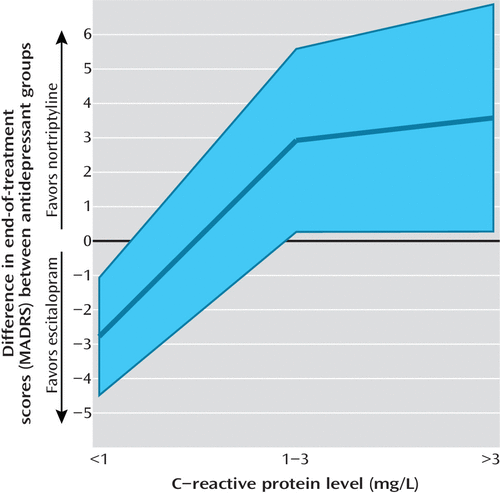In This Issue

Measurement of C-reactive protein is a commonly available test of systemic inflammation (Uher et al., p. Original article: 1278)
Biomarkers for Depression and Suicide
Biomarkers are one of the most desired contributions of research to clinical practice. This issue contains New Research articles on biomarkers for antidepressant response and suicide, as well as a Review and Overview of markers for suicide, a Commentary on their present and future role in the DSM, and an Editorial on these articles.
Bench to Bedlam
Kendler comments that (p. Original article: 1248) biomarkers can be used as part of clinical diagnosis. Once a biological measure is confirmed, he advises adding it to the other criteria for the disorder, not replacing them. For instance, the DSM-5 criteria for narcolepsy include a low level of CSF hypocretin and sleep polysomnographic results, but these have not supplanted clinical information. In his editorial, “From Bench to Bedlam,” Perlis (p. Original article: 1233) observes that laboratory bench discoveries of biomarkers are reminders that psychiatric disorders are brain diseases. He predicts that their principal use will be within research to find new treatment targets, rather than within clinical practice at the present. The legacy of Bedlam, one of the first hospitals for mentally ill patients, is recalled in the Image in Psychiatry of Tom of Bedlam, a character from Shakespeare’s time (p. Original article: 1257).
Inflammation and Antidepressant Response
In a multisite European study, Uher et al. (CME, p. Original article: 1278) found that the baseline level of C-reactive protein (CRP), an easily tested inflammatory indicator, predicted response to escitalopram and nortriptyline. A low CRP level (<1 mg/L) predicted better response to escitalopram, whereas patients with higher CRP levels were more likely to respond to nortriptyline (figure). Adding a rating of interest- and activity-related symptoms increased predictive ability, suggesting the possibility of combining biomarkers with clinical measures to predict antidepressant response.
DNA Methylation and Choice of Antidepressants
Wong et al. (p. Original article: 1297) report that fluoxetine had greater efficacy and a better side effect profile than desipramine in Mexican American patients with major depression. Patients whose depression remitted were distinguished from nonresponders by a functional intergenic single-nucleotide polymorphism that may be associated with brain DNA methylation.
A Genetic Marker for Suicide Risk
A postmortem study demonstrated that the combination of genotype and DNA methylation in a region of the SKA2 gene is associated with suicide. Guintivano et al. (CME, p. Original article: 1287) replicated the finding with suicidal ideation in living individuals. SKA2 genetic and epigenetic variation was also associated with the progression from suicidal ideation to suicide attempt in the presence of anxiety and stress. SKA2 expression has been implicated in glucocorticoid signaling, an important mechanism in depression and suicide.
Suicide and the Hypothalamic-Pituitary-Adrenal Axis
Abnormalities in corticotropin-releasing hormone (CRH) pathways are identified by Oquendo et al. (p. Original article: 1259) as prominent in the biosignature of suicide. Involvement of stress response mechanisms in suicide is also indicated by dysfunction at multiple levels in the hypothalamic-pituitary-adrenal (HPA) axis. Dysregulation in the CRH-HPA system has downstream effects that have also been linked to suicide, such as inflammatory and glutamatergic abnormalities. Whether suicide-related serotonergic findings are independent of stress response dysfunction is unresolved. Studying multiple systems in the same population may elucidate their interplay.



